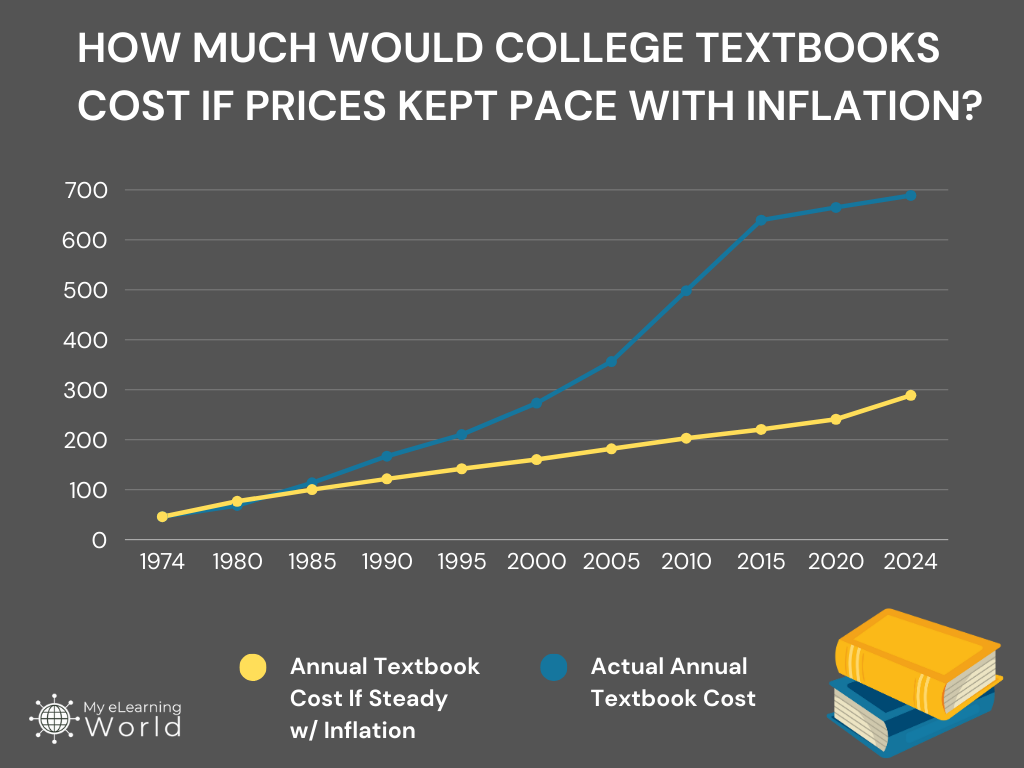Over the last 50 years, the cost of college textbooks has soared by a jaw-dropping 1401%, transforming what was once a manageable expense into a significant financial burden for students across the United States.
This staggering increase, which has seen textbook prices grow at nearly 3 times the rate of inflation, is more than just a statistic—it’s a barrier to education and a source of stress for millions of students trying to pay the already exorbitant costs of higher education.
We’ve put together a comprehensive report analyzing the reasons behind these soaring costs and their profound implications for student affordability and access to higher education.
Key Findings
Textbook prices have increased at 2.8X the rate of inflation since 1974
While the general cost of living has certainly increased, textbook prices have grown at nearly 3 times the rate of inflation over the past 50 years.
This disparity has contributed to the significant economic burden that’s placed on students who are pursuing higher education.
While textbook prices are skyrocketing, recreational books are getting cheaper
Textbooks have increased drastically in price over the years, but the cost of recreational books has actually declined. In other words, this isn’t a case of all books becoming more expensive — it’s a specific issue affecting the academic sector, where textbook prices have climbed at an alarming rate.
Over the last 25 years, while the relative price of college textbooks has surged by 167.6%, the price of recreational books has seen a modest decrease of 3.6% (source: Federal Reserve Economic Data).
Recreational reading, supported by a competitive market with various formats and distribution channels, including eBooks and online marketplaces, has become more accessible. In contrast, the textbook market, dominated by a handful of publishers with little incentive to keep prices low (more on this later), has seen costs balloon.
A college student have to work 96 hours at minimum wage to pay for a year of books
The average cost of a year of textbooks for a US college student is about $700. Using a federal minimum wage of $7.25 and average payroll taxes, we calculated a student would need to work around 100 hours to pay for their textbooks for a year.
With that in mind, it’s not surprising that studies have found 25% of students say that they have to work extra hours to pay for their books and materials, while 11% actually skip meals in order to afford books and course materials.
Even more concerning, 66% of students have at some point chosen not to purchase essential course materials due to their prohibitive cost, meaning that a significant portion of the student population is potentially compromising their academic success and understanding of course content. In fact, 20% of college course failures attributed directly to students’ inability to afford these essential resources.
This not only impacts their immediate learning outcomes but can also have long-term effects on their overall educational journey and career prospects.
The Dominance of a Few Publishers
A significant factor contributing to the out-of-control textbook prices is the market’s consolidation under the control of just five publishers: Pearson, McGraw Hill, Scholastic, Cengage Learning, and Houghton Mifflin Harcourt. Together, these companies command about 80% of the textbook market, limiting competition and allowing these publishers to set high prices without fear of losing market share.
The lack of competition in the textbook market means there’s little incentive for these publishers to reduce prices or innovate in ways that could make textbooks more affordable.
This control over the market has not only led to increased prices but also to practices that further inflate costs, such as the frequent release of new editions with minimal updates, making older, less expensive versions obsolete.
| Publisher | Annual Revenue |
|---|---|
| Pearson | $4.751 billion |
| McGraw Hill | $2.1 billion |
| Scholastic | $1.64 billion |
| Cengage | $1.35 billion |
| HMH (Houghton Mifflin Harcourt) | $1.2 billion |
Final Thoughts
This isn’t just about numbers—it’s about real students facing real challenges. Steadily-increasing textbook prices are putting the squeeze on students, making it tougher for them to access the materials they need for their education.
Some in Congress are trying to ease the burden on students with the introduction of the Affordable College Textbook Act. This legislation aims to tackle the textbook affordability crisis head-on by promoting the use of open textbooks and other open educational resources. These materials can be freely downloaded, edited, and shared, offering a lifeline to students burdened by the high costs of textbooks. Proponents of the legislation argue it will textbooks more affordable and help ensure that every student has access to the resources they need for their education.

